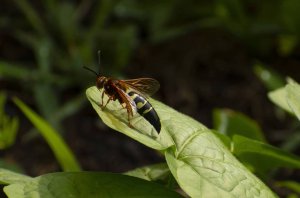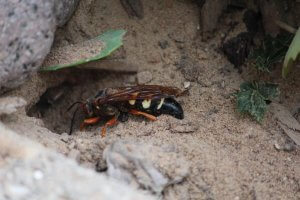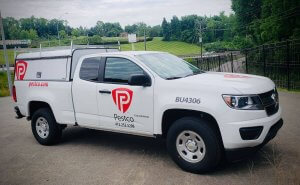With a moniker that might tell another story, the Cicada Killer Wasp is not as bad or dangerous to humans as many others are.
This is not to say they can’t be problematic in yards, lawns and gardens because in great numbers, they certainly can be.
Cicada killer wasps are found throughout the United States, Mexico and parts of Central America, but it is the species known as Sphecius convallis, that is primarily known in the western parts of the country, which includes the city and environs of Pittsburgh, Pennsylvania and our pest-control and pest-management specialists at Pestco Professional Services.
Description And Life Cycle Of The Cicada Killer Wasp
Cicada killer wasps have large, black and brown bodies that are scary to behold. They are known to grow as big as two inches in length.
Multi-colored with amber wings and bright yellow markings on their abdomens, visually they are the stuff of small nightmares albeit they do not sting humans pets and most living things unless they are handled roughly.
This excludes their chosen prey, which is vital to their existence; namely, cicadas. Males defend their nests by hovering around them, sometimes crashing into nearby insects.
They can be intimidating because of their size, but they usually just fly around humans. Females also fly about, always seeking spots to dig tunnels and hapless cicadas hiding in nearby shrubs and trees.
Male cicada killer wasps have a false stinger that is just a pointy projection on their abdomen that lacks power or venom.
Females mostly user their stingers to paralyze the cicadas they hunt.
The sting can be very painful, but is rare for humans experience them. Unlike other types of wasps, people can walk by nesting areas without causing any reaction or attracting attention from the protectors of the tunnels.
Cicada killer wasps emerge in late June and July
While the males die soon after mating, females are known to remain active for a period of a few more months when they dig burrows in soft sandy well-drained soil, backyards, patio and sidewalk edges, sloped terrain and flower beds.
This places nesting sites close to homes, verandahs, gardens, and cicadas, which means that more than one female cicada wasp killer may share a certain spot. These insects are solitary in nature, but they do often share nesting sites.

Cicada Nesting And Brutal Survival
Females construct their nests underground with several extending sections that veer off from the main nesting tunnel, which serve as a nursery for their young.
Survival instinct is the stuff of horror movies, for the nest steps involves the capture and paralysis via stinging of a cicada that is then hauled back into the tunnel and stuffed into a section where she then lays an egg inside it and seals off entry.
With the frightening precision of an Edgar Allen Poe tale, the egg then hatches in a few days, and the cicada, which is still alive, becomes food for the new larvae for the next two weeks.
Once mature, it spins a cocoon where it remains until the next summer from which it emerges as an adult. Cicada killer wasps develop one generation per year.
What Do The Cicada Killer Wasp Tunnels Look Like?
These tunnels are easily recognizable by the U-shaped mound of loose soil surrounding the opening.
They can range in length from 12 to 15 inches below the ground. Each tunnel contains about 15 separate chambers, the first of which lies a foot or so from the entrance.

The other egg-shaped chambers contain 1 to 3 paralyzed cicadas and one egg, which usually hatches within 2 to 3 days.
The emerging larvae feed for a period of some 10 days, at the end of which only the outer shell of the cicada remains to rot.
When preparing for the colder months of the year, the larva spin a silken case, shrink in size and prepare for the winter.
Cicada Killer Wasp And The Damage They Do To Property
When called to the scene of a cicada wasp killer infestation, our pest management specialists are often confronted with a severe disruption of soil surrounding a home.
As much as 100 cubic inches can reach surface ground as tunnels are formed, creating both an unsightly appearance and possibly a smothering of lawn grass growth.
The population builds rapidly, and an estimated 40% of developing larvae may emerge all at once.
Further damage sometimes ensues when a skunk or some other curious animal attracted to the tunnels may feed on both the cicada and the wasp larvae.
The Cicada In Mother Nature’s Order Of Things
Like all living things, cicadas have a place in nature that many believe supersede the fact that they can be a destructive nuisance.
They provide a vital link in the food chain between trees and the animals that see them as prey. The sun and nutrients in the soil nourish the trees, which in turn provide haven and food for cicadas.
Cicadas release vast amounts of nutrients back into the soil after they die. They are the favored fare for the cicada wasp killers that in turn also get eaten by alpha predators such as bears, foxes, wolves and even people in some cultures.
In terms of fungi, some digest dead cicada bodies once the carcasses begin to rot, particularly the Massospora cicadina fungus, which also becomes another link in the food chain.
Protecting Pittsburgh Property From Cicada Killer Wasps
Fore-warned is fore-armed as the old saying goes, and our pest-control and pest-management experts at Pestco advise that protecting your Pittsburgh home and property from invading cicada wasp killers means doing some homework and learning about their behavior, habitat and the control options that are available.

Keeping your backyard safe from these nesting critters is a daunting task that must be expertly performed.
A home owner destroying or upsetting their burrows and mounds may find him or herself making a hole in water, as the female cicada wasp killer will only dig a new chamber nearby upon returning from her deadly hunt for cicadas.
Pittsburgh home owners can easily be fooled about nest locations because not all of the burrows have visible mounds alerting their presence.
This occurs either because the burrow is on a steep hill, which causes soil to roll away as it is being dug, or in a windy area that blows the top soil away. It may also be simply a matter of choice to the queen wasp.
This is why professional help is necessary, and as soon as possible.
That old saying about an ounce of prevention being worth a pound of cure aptly applies when it comes to preventing a cicada wasp infestation on a Pittsburgh home or residence.

A well-maintained lawn is the best preventive measure, as it does not expose bare areas of soil, which are irresistible attractions for cicada wasp killers.
Pest-control experts advise that allowing your lawn to grow a bit longer is particularly important in July and August
The removal of cicada killer wasps requires patience and meticulous attention to detail because each and every burrow must be located and treated with a series of strategies.
Complicating the process is the timing involved, as solutions must be employed only when the queen is there and has returned from her hunt.
The annihilation of these burrows and the insects inside cannot always eradicate the site’s appeal to newer populations of cicada killer wasps for as long as their basic needs are met.
Call our teams today if an infestation of any type has taken hold on your property.
We’re always on hand to help with the friendliest pest control servicing in all of Greater Pitt!
 Over 300 Reviews
Over 300 Reviews 